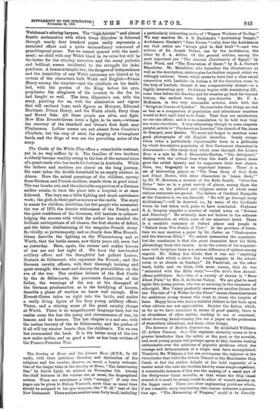The Sunday at Home and the Leisure Hour (R.T.S., 7s.
6d. each), with their judicious blending and distinction of the religious and the secular, deserve, as usual, a hearty welcome. One of the longer tales in the Sunday at Home, "The Intervening Sea," by David Lyall, we noticed on November 7th. Among the chief features of the volume are, as usual, the biographical notices. These are sometimes a little "scrappy." If only two pages can be given to Bishop Westcott, more than as many lines should be assigned to his opus magnum, the "W.-H." text of the New Testament. These notices number some forty in all, including a particularly interesting series of "Women 'Workers of To-Day." We may mention Mr. A. R. Buckland's " Archbishop Temple," Archdeacon Sinclair's "Dean Farrar "—why does the Archdeacon say that critics are "always glad to find fault" P—and two notices of Dr. Joseph Parker, one by the Archdeacon, the other by F. A. Atkins. Of the general articles, among the most important are " Tho Ancient Christianity of Egypt," by John Ward, and "The Excavation of Gezer," by R. A. Stewart Macalister. Mr Macalister, who furnishes the illustrations as well as the description, makes a plea for further support, which we willingly endorse. Gezer, which seems to have had a close racial connection with Lachish—in Joshua x. 33 the Gezerites come to the help of Lachish, though it was comparatively distant—is a highly interesting spot. Its history begins with Amenhotep ILL, some time before the Exodus, and its remains go back far beyond history, the earliest town being pre-Amorite. Mr. F. A. McKenzie, in two very reasonable articles, deals with the "Religious Census of London." He concludes that things are not as bad as a comparison of population and attendance numbers would at first sight lead us to think. That they are satisfactory no one can affirm ; and it is no consolation to be told that they are worse elsewhere. A very interesting, though in some respects painful, article is " The American Lourdes," the church of Ste. Anne de Beaupre, near Quebec. We must not forget to mention some good photographs of old English churches. Surely compe- tition takes a particularly objectionable form in a plebiscite by which the relative popularity of New Testament characters is determined.-----The serial story which runs through the Leisure Hour is a tale by Mr. J. Bloundelle-Burton, "The Intriguers," dealing with the critical time when the death of Queen Anne gave the exiled dynasty and its supporters their best chance. Here, too, biography is an important feature. There is a set of interesting papers on "The True Story of Seth Bede and Dinah Morris, with other Characters in 'Adam Bede," by Mr. W. Mottram, a member of the Bede family. "Over-Sea Notes" take us to a great variety of places, among them the Vatican, on the political and religious action of which some curious comments are passed. The failure of Cardinal Rampolla at the Conclave is, we see, foretold. "He will go through many disillusions,"—will be deserted, i.e., by many of the Cardinals whom he had taken such pains to have nominated. Professor R. A. Gregory supplies a number of varied notes on "Science and Discovery." He evidently does not believe in the extreme of specialisation on which some of our scientists insist. There is a readable summary of Oxford places and people in "Oxford from Two Points of View." In the province of litera- ture we may mention a paper by Dr. Carter on "Shakespeare and the Genevan Bible." We cannot summarise the argument, but the conclusion is that the great dramatist drew his Bible phraseology from this version. As to the extent of his acquaint- ance with Scripture there is a curious difference of opinion among experts. Mr. Sidney Lee thinks that it was not "anything beyond that which a clever boy would acquire in the school- room or at church on Sundays." Dr. Furnivall, on the other hand, holds, and, we think, with more reason, that he was "saturated with the Bible story."—The Girl's Own Annual. (Same publishers. 8s.)—One of a variety of stories is "More About Pixie," by Mrs. G. de Horne Vaizey. We are glad to meet again this young person, who was so amusing in the character of schoolgirl. Mrs. Vaizey prudently reserves yet another future for her. The tale of "A Writer for the Press" means disenchantment for ambitious young women who avant to storm the heights of fame. Happy those who have a faithful Gilbert to fall back upon when editors are not appreciative. Besides the fiction, which, as far as we have examined it, seems of good quality, there is an abundance of other matter, tending to use or ornament, about dressing, bread-winning (we see a paper on the profession of elementary education), and many other things,


























































 Previous page
Previous page